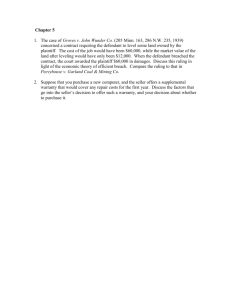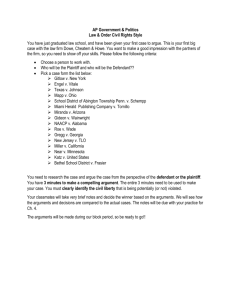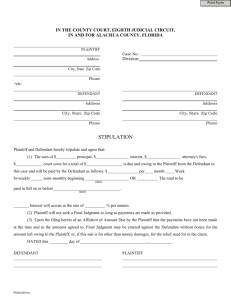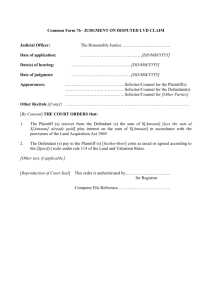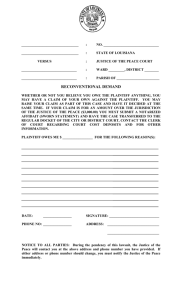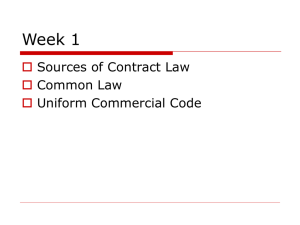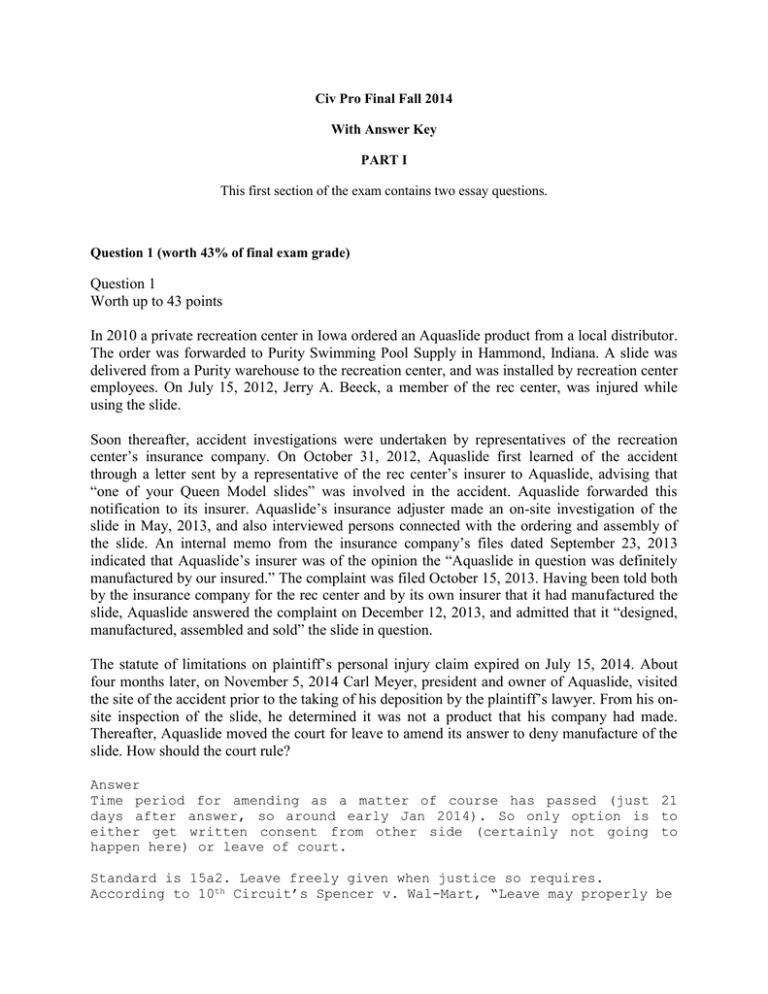
Civ Pro Final Fall 2014
With Answer Key
PART I
This first section of the exam contains two essay questions.
Question 1 (worth 43% of final exam grade)
Question 1
Worth up to 43 points
In 2010 a private recreation center in Iowa ordered an Aquaslide product from a local distributor.
The order was forwarded to Purity Swimming Pool Supply in Hammond, Indiana. A slide was
delivered from a Purity warehouse to the recreation center, and was installed by recreation center
employees. On July 15, 2012, Jerry A. Beeck, a member of the rec center, was injured while
using the slide.
Soon thereafter, accident investigations were undertaken by representatives of the recreation
center’s insurance company. On October 31, 2012, Aquaslide first learned of the accident
through a letter sent by a representative of the rec center’s insurer to Aquaslide, advising that
“one of your Queen Model slides” was involved in the accident. Aquaslide forwarded this
notification to its insurer. Aquaslide’s insurance adjuster made an on-site investigation of the
slide in May, 2013, and also interviewed persons connected with the ordering and assembly of
the slide. An internal memo from the insurance company’s files dated September 23, 2013
indicated that Aquaslide’s insurer was of the opinion the “Aquaslide in question was definitely
manufactured by our insured.” The complaint was filed October 15, 2013. Having been told both
by the insurance company for the rec center and by its own insurer that it had manufactured the
slide, Aquaslide answered the complaint on December 12, 2013, and admitted that it “designed,
manufactured, assembled and sold” the slide in question.
The statute of limitations on plaintiff’s personal injury claim expired on July 15, 2014. About
four months later, on November 5, 2014 Carl Meyer, president and owner of Aquaslide, visited
the site of the accident prior to the taking of his deposition by the plaintiff’s lawyer. From his onsite inspection of the slide, he determined it was not a product that his company had made.
Thereafter, Aquaslide moved the court for leave to amend its answer to deny manufacture of the
slide. How should the court rule?
Answer
Time period for amending as a matter of course has passed (just 21
days after answer, so around early Jan 2014). So only option is to
either get written consent from other side (certainly not going to
happen here) or leave of court.
Standard is 15a2. Leave freely given when justice so requires.
According to 10th Circuit’s Spencer v. Wal-Mart, “Leave may properly be
denied by the district court if it finds "undue delay, bad faith or
dilatory motive on the part of the movant, repeated failure to cure
deficiencies by amendments previously allowed, undue prejudice to the
opposing party by virtue of allowance of the amendment, [or] futility
of amendment.” Similar standard as described by SDNY’s decision in On
Track v. T-Mobile (in Course Materials), “Under this liberal standard,
motions to amend should be denied only for reasons of undue delay, bad
faith or dilatory motive, undue prejudice to the non-moving party, or
futility.”
None of the other reasons for denying leave to amend apply- so
question is only delay and prejudice
Bad faith and Dilatory Motive are not applicable here. According to On
Track, bad faith is about whether decision to hold off on amendment
was for “strategic advantage.” There’s nothing to indicate that
Aquaslide intentionally waited. Indeed, if they had known about it
sooner they would almost certainly have asked promptly for change
since it would likely mean their dismissal from the case. They had no
motive to delay.
Repeated failure to cure deficiencies by amendments, and “futility of
amendment” both not applicable. Thus, focus to turns to undue delay
and prejudice.
Undue Delay
For starters, if undue delay has occurred, that—standing alone—is
enough to justify denying leave to amend, according to Spencer. Undue
prejudice not also required by 10th Circuit. By comparison, according
to SDNY’s decision in On Track v. T-Mobil, delay is a relevant factor
in 2d circuit, but delay alone isn’t enough: court specifically says
must have delay and prejudice together.
So first- is there even inordinate delay? Pretty strong arg that
answer is yes. Delay is defined by On Track as “where the motion is
made after an inordinate delay, [and] no satisfactory explanation is
offered for the delay.” On Track. Under Spencer v Wal-Mart, similar
formulation as to delay: not just any delay, but must be “undue”
delay. And in figuring out if delay was undue Spencer said: “In
determining whether the delay was undue, we consider both the length
of the delay and the reason for its occurrence.”
So do we have inordinate/undue delay here for which no satisfactory
explanation was offered? To be sure, cases note that delay can be up
to one year or longer and not be deemed undue delay. Here, by
contrast, delay was roughly one year or less. So question about delay
really will turn on whether reliance on the insurance comp statements
provides justifiable reason for waiting so long to check slide
themselves and, upon finding that it wasn’t their slide, seeking to
amend their answer.
In Spencer v. Wal mart, in finding that there was undue delay by
Plaintiff before seeking to amend, court emphasized that focus should
be on whether facts were known “or should have been known”:
Their claim for deceit and their assumption of duty theory of
negligence, both based on Wal-Mart's allegedly fraudulent
representation that it was monitoring its video cameras, have
been evident throughout the proceedings. Facts necessary to
support these claims were known or should have been known to the
Spencers at the time the original complaint was filed…
Here, arguably, Aquaslide should have known that the slide wasn’t its
slide by time it filed its answer. If it chose to rely on what its own
insurer told it, without doing its own investigation, that is on it;
it certainly could have figured it out back when it filed its answer.
By comparison, the On Track Innovations case found no undue delay
because it found there was a new event that occurred that justified
plaintiff waiting as long as it did to seek amendment. Here, the event
that occurred (CEO looking at the slide closely) could have occurred
at any point earlier if Aquaslide had bothered to look. Thus, under
both Spencer and On Track, a strong—but not unassailable--arg for
delay can be made.
Was there undue prejudice?
Note first that it isn’t entirely clear that undue prejudice, standing
alone, is enough according to On Track [and Spencer court never
addresses prejudice independently, so we can’t say as much about
Spencer court]. Certainly there is a strong argument that it would be:
language in On Track reads: “motions to amend should be denied only
for reasons of undue delay, bad faith or dilatory motive, undue
prejudice to the non-moving party, or futility.” Moreover, if there is
undue prejudice, seems like that really should be enough: it is the
factor of delay, standing alone, that makes more sense to potentially
not be an independent factor
Seems very likely that there is undue prejudice here since SOL has
run. According to On Track, “In deciding whether undue prejudice
exists, courts should consider whether the new claim would “prevent
the plaintiff from bringing a timely action in another jurisdiction.”
[Spencer court never addresses what is undue prejudice because it
finds that there was undue delay and that that alone is enough to
justify denying leave to amend.] Only if there’s a way to make
otherwise expired claims timely again (by way of state or fed relation
back law, or some other tolling of limitations), then acquaslide’s
failure to confirm if it was its slide arguably has caused undue
prejudice since plaintiff relied on their admission back before
limitations had run that it was their slide.
We aren’t told anything about state relation back law or about any
state tolling devices, so only possibility we can consider is the fed
relation back rule of Rule 15 c1c. However, 15c1C almost certainly
will not allow relation back: not just a name change of the party; and
exam prompt doesn’t say anything about the actual manufacturer of
slide having any notice of the action and that it knew or should have
known that but for a mistake it would have been joined.
So, in sum, it appears that a very strong arg can be made that there
is undue prejudice to P to allow the amendment now. Both On Track and
Spencer courts consider undue prejudice as an independent factor
So, framework looks like this:
Matter of course amendment not
available
Exc
VG
G
PG
F
P
4
3.5
3
2.5
2
1 or less
15a2- other factors beyond delay
and prejudice not applicable at
all
Exc
VG
G
PG
F
P
3
2.5
2
1.5
1
0
Delay
Key issues:
Exc
VG
G
PG
F
P
18
15
12
9
6
3 or less
Exc
VG
G
PG
F
P
18
15
12
9
6
3 or less
1. not just any delay; undue delay
2. perhaps not just delay; On
Track said also need undue
prejudice; spencer said delay
alone
3. whether reliance on ins company
justifies A’s delay
Prejudice- primary focus needs to
be on whether claim would now be
stale against actual manufacturer.
So focus needs to be on 15c1c
Question 2 (worth 42% of final exam grade)
In 2005, Houston artists Dan Havel and Dean Ruck used wooden house boards to create a jagged, portallike conical sculpture that drew the viewer from the front to the back of a house located in the city’s
eclectic Montrose neighborhood. The sculpture, entitled Inversion, has a registered copyright. Inversion
was torn down later that year, but photographs—also copyrighted—remain. Here is an image of the
sculpture:
Roughly seven years later, employees at a London-based British advertising agency, McGarry Bowen
UK, stumbled on some of these images on the internet while working on a pitch to present to Honda
Motor Europe Ltd. to create a commercial for the European debut of a CR-V model Honda vehicle.
McGarry Bowen UK provides advertising and marketing services to companies selling goods and
services in Europe.
As the pitch-development work unfolded, the McGarry Bowen UK creative team members narrowed the
concept to a portal. One of these portal concepts closely resembled Dan Havel and Dean Ruck’s
Inversion, both in material (wooden boards) and style (long, conical, and with a trumpet-head like
opening). Two McGarry Bowen UK employees primarily originated and developed the portal idea.
McGarry Bowen UK used the Inversion images in its final presentation to Honda Europe and received
the production contract.
On July 17, 2012, Jim Kelly, McGarry Bowen UK’s CEO, circulated an email entitled “Houston Hole
house video” to five McGarry Bowen UK employees. The email contained a hyperlink to a video
depiction of Inversion on the website www.arteryhouston.org. The www.arteryhouston.org website is
administered by Artery Media Project, “a Houston based organization created to support the promotion of
interdisciplinary works of art focusing on local Houston artists.” According to the organization’s founder,
the link Kelly circulated in 2012 would have accessed a “video depicting the creation and final
installation of Dan Havel and Dean Ruck’s sculpture, Inversion.” The website “prominently displays a
copyright notice on all of its pages, noting expressly ‘all rights reserved,’” and the “website makes clear
that we are based in Houston, including by providing our mapped Houston address and, of course,
through use of the name of the website.”
Presumably concerned about the copyright, the commercial’s producer, who also worked for McGarry
Bowen UK, called Dean Ruck in Houston. The parties dispute the result of the phone and email
communications that ensued. Ruck believed that the commercial might feature the general concept of a
portal stretching through a wooden house structure but would not use Inversion images or anything too
similar. The commercial’s producer, on the other hand, believed that Ruck consented to the agency’s use
of his copyrighted material as long as the commercial did not use an actual image of Inversion.
McGarry Bowen UK’s production team used the photograph and built a replica of Inversion to use in
filming the commercial. When Ruck learned that McGarry Bowen UK had built what was close to an
Inversion replica, he promptly notified the agency that he disputed its right to do so. Ruck told the agency
that it had misinformed him in the earlier call and emails. The producer and Ruck exchanged a few more
emails but were unable to resolve their disagreement. The television commercial began airing in Europe
in October 2012. Several months later, Ruck and Havel sued McGarry Bowen UK in Texas federal
court, alleging copyright infringement and state-law fraud. Defendant moved to dismiss for lack of
personal jurisdiction. Assume that the Texas long arm statute has been interpreted to reach to the full
extent of due process. How should the court rule?
(closely based on Havel and Ruck v. Honda Motor Europe, No. H-13-1291, opinion by the Honorable Lee
Rosenthal)
Answer:
“A federal court sitting in diversity may exercise personal jurisdiction over a non-resident
defendant (1) as allowed under the state’s long-arm statute; and (2) to the extent permitted by the
Due Process Clause of the Fourteenth Amendment.” The Texas long-arm statute extends to the
limits of due process, according to the prompt (it also turns out be true under how LA has been
interpreted.
DP
To satisfy due process, the plaintiff must demonstrate “(1) that the non-resident purposefully
availed himself of the benefits and protections of the forum state by establishing ‘minimum
contacts’ with the state; and (2) that the exercise of jurisdiction does not offend ‘traditional
notions of fair play and substantial justice.’”
1. MC
“A defendant establishes minimum contacts with a state if ‘the defendant’s conduct and
connection with the forum state are such that [he] should reasonably anticipate being haled into
court there.’” Burger King Corp. v. Rudzewicz, 471 U.S. 462, 474 (1985)). “There are two types
of ‘minimum contacts’: those that give rise to specific personal jurisdiction and those that give
rise to general personal jurisdiction.” Lewis v. Fresne, 252 F.3d 352, 358 (5th Cir. 2001).
A. GJ inapplicable
Walk through Daimler and Goodyear standard: for corporation, “essentially at home” is only in
place of incorporation (here, outside US); and PPB (here, outside US).
Might also mention that can’t attribute contacts for GJ purposes, it seems, after goodyear.
B. SJ
Specific personal jurisdiction “is confined to adjudication of ‘issues deriving from, or
connected with, the very controversy that establishes jurisdiction.’” Goodyear Dunlop Tires
Operations, S.A. v. Brown, 131 S. Ct. 2846, 2851 (2011) (citation omitted). The question is
“whether there was ‘some act by which the defendant purposefully avail[ed] [himself] of the
privilege of conducting activities within the forum State, thus invoking the benefits and
protections of its laws.’” Id. at 2854 (quoting Hanson v. Denckla, 357 U.S. 235, 253 (1958)).
“For a State to exercise jurisdiction consistent with due process, the defendant’s suit-related
conduct must create a substantial connection with the forum State.” Walden v. Fiore, 134 S. Ct.
1115, 1121 (2014). A court considers two issues in deciding whether a defendant’s suit-related
conduct creates a sufficient relationship with the forum state. See id. at 1122. “First, the
relationship must arise out of contacts that the ‘defendant himself’ creates with the forum State.”
Id. (quoting Burger King, 471 U.S. at 475). The limits imposed on a state’s “adjudicative
authority principally protect the liberty of the nonresident defendant—not the convenience of the
plaintiff[] or third parties.” Id. (citing World-Wide Volkswagen Corp. v. Woodson, 444 U.S. 286,
291–92 (1980)). The Supreme Court has “consistently rejected attempts to satisfy the defendantfocused ‘minimum contacts’ inquiry by demonstrating contacts between the plaintiff (or third
parties) and the forum State.” Id. (citing Helicopteros Nacionales de Colombia, S.A. v. Hall, 466
U.S. 408, 417 (1984)). The “unilateral activity of another party or a third person is not an
appropriate consideration when determining whether a defendant has sufficient contacts with a
forum State to justify an assertion of jurisdiction.” Id. “Put simply, however significant the
plaintiff’s contacts with the forum may be, those contacts cannot be ‘decisive in determining
whether the defendant’s due process rights are violated.’” Id.
“Second, [the] ‘minimum contacts’ analysis looks to the defendant’s contacts with the forum
State itself, not the defendant’s contacts with persons who reside there.” Id. (citations omitted). A
“plaintiff cannot be the only link between the defendant and the forum. Rather, it is the
defendant’s conduct that must form the necessary connection with the forum State that is the
basis for its jurisdiction over him.” Id. “[A] defendant’s contacts with the forum State may be
intertwined with his transactions or interactions with the plaintiff or other parties. But a
defendant’s relationship with a plaintiff or third party, standing alone, is an insufficient basis for
jurisdiction.” Id. at 1123. “Due process requires that a defendant be haled into court in a forum
State based on his own affiliation with the State, not based on the random, fortuitous, or
attenuated contacts he makes by interacting with other persons affiliated with the State.”
Application
The plaintiffs’ allegations raise a plausible inference that McGarry Bowen UK and its
employees had a front-row seat to, and at times an active role in, appropriating Inversion, a
copyrighted Houston-based sculpture, from Houston-based artists. McGarry Bowen UK’s
creative team members discovered Inversion images (which were necessarily taken in Houston)
on Pinterest, added Inversion images with superimposed Honda CR-Vs to their pitchbook, and
included Inversion images in their final presentation to Honda Europe. Many images of Inversion
credit the sculpture’s artists and location, and carry copyright notices. The plaintiffs plausibly
allege that McGarry Bowen UK employees knew the Houston location of the sculpture and its
creators throughout. The question is whether these contacts are too “random, fortuitous, or
attenuated” to satisfy due process because they stemmed more from Ruck and Havel’s (and
Inversion’s) connection to Houston, or whether they are sufficient to meet the due process test.
When viewed alongside McGarry Bowen UK’s subsequent acts connecting them to Houston,
Texas and to the intellectual property created and displayed there, “not just to a plaintiff who
lived there,” these contacts are enough. See Walden, 134 S. Ct. at 1124.
After the successful pitch and during the development process, but before the set was built,
McGarry Bowen UK’s CEO, Jim Kelly, circulated an email to five members of the creative team
entitled “Houston Hole house video.”
Larsen’s sworn declaration also states that the Inversion video on the Artery Houston website
prominently displayed a copyright notice. (The website made it clear that Inversion and its
creators were firmly tied to Houston. Even if the above contacts are not sufficient, they surely
are enough when paired with internal emails suggesting that McGarry Bowen UK executives
knew of and condoned, or actively supported, Hitchings’s deceptive phone call with and emails
to Houston to obtain permission from Houston residents Dean Ruck and Dan Havel to use the
design and images of their Houston sculpture, Inversion.
McGarry Bowen UK’s “suit-related conduct” created “a substantial connection with” Texas,
such that exercising jurisdiction does not offend traditional notions of fair play and substantial
justice. The court denies McGarry Bowen’s motion to dismiss for lack of personal jurisdiction.
Framework for answer looks like this:
General Jurisdiction
E
VG
Walk through Goodyear and Daimler
G
PG
F
P
Specific Jurisdiction
E
VG
Walk through two part DP test; focus G
especially on Walden v Fiore standard for PG
intentional tort cases.
F
P
21
17
13
9
5
0-1
21
17
13
9
5
0-1
PART II
This second section, worth 15% of the final exam grade, contains 15 multiple choice questions. Each
multiple choice question is worth one point each. You should mark your answers to the multiple choice
questions on the scantron answer sheet provided.
1.
Plaintiff sues her employer for job discrimination in federal court. Two weeks later the
employer moves to dismiss for failure to state a claim on which relief can be granted, citing the
plausibility pleading standard of Bell Atlantic v. Twombly and Ashcroft v. Iqbal. Which of these
is the strongest argument for denying the motion?
A.
The motion should be denied if it relies on evidence beyond the pleadings.
B.
The motion should be denied if, assuming that evidence would eventually be
introduced to support the allegations, the allegations raise a plausible right to relief.
C.
The motion should be denied if it is not supported by any competent evidence.
D.
The motion should be denied if it is not supported by any evidence.
2.
Two weeks after defendant is sued in federal court, she files a preanswer motion to
dismiss for lack of subject matter jurisdiction. A month later, before the Court has ruled on the
motion, defendant realizes that she should have filed a motion to dismiss for improper venue.
Which of the following is correct?
A.
She has waived her right to seek dismissal for improper venue.
B.
She has not waived her right to seek dismissal for improper venue because of the
exception in Rule 12(h)(3).
C.
She has waived her right to seek dismissal by preanswer motion but can still ask the court
to dismiss for improper venue whenever she files her answer.
D.
She has waived her right to seek dismissal by preanswer motion but can still ask the court
to dismiss for improper venue in her answer, as long as she files her answer no later than
14 days after the court rules on her subject matter dismissal motion under Rule 12(a)(4).
3.
Paul sues David in federal court. David timely files an answer and counterclaim. A month
later, David moves for entry of a default judgment on the ground that Paul failed to respond to
the counterclaim. How should the court rule?
A.
The court should enter a default judgment in favor of David on his counterclaim against
Paul only if David properly and timely served an official summons on Paul under Rule 4.
B.
The court should enter a default judgment in favor of David on his counterclaim against
Paul only if David can show that Paul is subject to personal jurisdiction in the forum.
C.
The court should enter a default judgment on the counterclaim against Paul and he
need not serve Paul with an official summons and need not demonstrate Paul is
subject to personal jurisdiction in the forum.
D.
The court should enter a default judgment against Paul on the counterclaim and dismiss
the entire action.
4.
Plaintiff sues defendant for negligence in federal court. Paragraphs 6-10 of the complaint
spell out how defendant’s conduct fell below the standard of care. Defendant timely files an
answer admitting all of the allegations in paragraphs 6-10, denying all other allegations.
Thereafter, Plaintiff moves for partial summary judgment as to defendant’s negligent conduct.
How should the court rule?
A.
It should deny the motion on the ground that only defendants can move for summary
dismissals before trial.
B.
It should deny the motion because the plaintiff bears the burden of proof on all of the
elements of her claim (duty, negligence, causation and damages); summary judgment is
not appropriate as to a single element only.
C.
It should grant the motion.
D.
It should grant the motion but only on condition that the defendant does not later seek to
amend its answer to deny the allegations.
5.
Plaintiff brings suit in federal court against defendant, who timely files an answer. A
month later, defendant seeks to amend her answer to add an affirmative defense that the
plaintiff’s claims are barred by the statutory defense of comparative liability. Which of the
following is the strongest argument the plaintiff can make against the proposed amendment?
A.
The court should deny the amendment because the statutory defense is not included in the
list of affirmative defenses under Rule 8(c)
B.
The court should deny the amendment if it finds that the defendant waited too long to
seek to amend under Rule 15(a)(1)(A); that is, defendant had only 21 days after serving
her answer to move to amend.
C.
The court should deny the amendment if it finds that the defendant waited too long to
seek to amend. Under Rule 15(a)(1)(B); that is, defendant had only 21 days after service
of plaintiff’s responsive pleading or 21 days after service of a motion under Rule 12(b),
(e) or (f0, whichever was earlier.
D.
The court should deny the amendment if it finds that justice does not require
allowing the amendment under Rule 15(a)(2).
6.
Plaintiff sues defendant in the United States District Court for the Southern District of
Texas. Her sole claim for relief is for intentional infliction of emotional distress. Assume that
currently, under Texas law, there is no such cause of action but that a case is pending before the
Texas Supreme Court in which the sole issue is whether such a cause of action should exists in
Texas. Defendant moves to dismiss for failure to state a claim on which relief can be granted and
also seeks sanctions against plaintiff under Rule 11. What is the strongest argument that plaintiff
can make against the imposition of monetary sanctions?
A.
Sanctions are not appropriate if the plaintiff can show that his factual contentions have
evidentiary support or will likely have evidentiary support.
B.
Sanctions are not appropriate if the plaintiff can show that his lawyer, not he, suggested
suing for intentional infliction of emotional distress.
C.
Sanctions are not appropriate because only the court can order a party to show cause why
its conduct has not violated Rule 11.
D.
Sanctions are not appropriate against the plaintiff since the Texas Supreme Court
may rule that the cause of action exists.
7.
Plaintiff, who lives in Houston, files suit in the United States District Court for the
Southern District of Texas claiming that while he was working in Florida the defendant
discriminated against him in violation of federal law. At the time of the suit, Defendant had
moved to Oklahoma, where he intended to reside permanently. Other than plaintiff and
defendant, all other witnesses in the case live in Florida. Defendant moves for a change of venue
to Oklahoma or, alternatively, to Florida. What is the most likely result?
A.
The action may be dismissed since it was commenced in an improper forum, or
transferred to Oklahoma or Florida.
B.
The action must be dismissed since it was commenced in an improper forum.
C.
The action may be transferred to Oklahoma, only.
D.
The action may be heard in the Texas federal court since it was commenced in a proper
forum.
8.
Plaintiff, a citizen of Texas, filed suit against defendant in Harris County district court in
Houston, alleging employment discrimination under federal law. Defendant, also a citizen of
Texas but living in Dallas, Texas, filed a petition for removal to the in the United States District
Court for the Northern District of Texas Which of the following is correct?
A.
The action was properly removed.
B.
The action was improperly removed; under 1441(b), the forum defendant rule, the case
was not removable because defendant is a Texas citizen.
C.
The action was improperly removed to the wrong district court.
D.
The action was improperly removed because the Notice of Removal failed to set forth the
amount in controversy.
9.
Plaintiff, from Texas, brings suit in federal court against defendant, from New York, on a
state cause of action for $100,000. Defendant impleads Tom, also from New York, claiming that
Tom owes him statutory indemnity for any liability he may be found to owe plaintiff. Which of
the following is correct?
A.
Defendant can maintain his indemnity claim against Tom in the same suit.
B.
Defendant cannot maintain his indemnity claim against Tom in the same suit because
there is no diversity of citizenship between the parties.
C.
Defendant can maintain his indemnity claim against Tom in the same suit, but only if the
amount-in-controversy exceeds $75,000.
D.
Defendant can maintain his indemnity claim against Tom in the same suit, but only if the
source of statutory indemnity is federal law.
10.
If one party seeks discovery of a written statement of a non-party witnesses that has been secured
by an adverse party’s counsel in the course of preparation for possible litigation after a claim has arisen,
which of the following is true under Rule 26?
A.
A written witness statement is discoverable by the party seeking the statement, without regard to
whether it is a verbatim statement of the witness or includes mental impressions, conclusions,
opinions or legal theories of the adverse party’s counsel.
B.
A written witness statement is discoverable by the party seeking the statement if that party
shows that it has substantial need for the statement to prepare its case and cannot, without
undue hardship obtain its substantial equivalent by other means.
C.
If the written statement includes mental impressions, conclusions, opinions or legal theories of
the adverse party’s counsel, then the statement is discoverable by the party seeking the statement
on a showing of extraordinary circumstances, but without regard to whether the party has
substantial need for it.
D.
If the witness statement was communicated in confidence to the adverse party’s counsel, then it is
exempt from discovery under the attorney-client privilege.
11.
Plaintiff, a citizen of Kansas, filed an action in the United States District Court for the
District of Kansas against D1, a Texas corporation, and D2, a Louisiana corporation, alleging
that defendants were both liable for negligence and (2) that plaintiff’s actual damages were
$70,000. Which of the following is true?
A.
The case can remain in federal court because the claims against D1 and D2 can be
aggregated to $150,000, thereby exceeding the minimum amount in controversy.
B.
The case can remain in federal court only if the plaintiff can show that her claims against
D1 and D2 arise out of the same transaction or occurrence or series or transactions or
occurrences, and any common question of law or fact will arise in the action.
C.
The entire case should be dismissed.
D.
The court has discretion to decide to retain the case if it finds that it would be in the
interest of justice to do so.
12.
Plaintiff, a New York citizen, files suit against defendant, a Delaware company with its principal
place of business in New York, in the United States District Court for the Southern District of Texas.
(Plaintiff has substantial other business dealings in Texas.) The suit concerns a contract plaintiff alleges
defendant breached that was to be performed entirely in Oklahoma and New York. Assume there is a
valid forum selection clause in which the parties agreed in advance that any dispute between them would
be litigated in a court in New York. Defendant files a motion to dismiss or, in the alternative, to transfer
the case to the Southern District of New York under 28 U.S.C. §1406. Which of the following is correct?
A.
The Southern District of Texas was not a proper venue, but after Atlantic Marine the proper
statutory section to invoke was §1404.
B.
The Southern District of Texas was not a proper venue, but even after Atlantic Marine the
proper statutory section to invoke was § 1406.
C.
Because the Southern District of Texas was not a proper venue, the proper procedural ground for
this motion was the federal doctrine of forum non conveniens.
D.
Because the Southern District of Texas was not a proper venue, the only proper procedural
ground for this motion was to seek dismissal under Rule 12(b)(3).
[note: question 13 not counted because of mistake in answers (references to Texgumbo should
be have been to Bubba’s)]
13.
Texgumbo, Inc. is owned by Guy Lemont. Texgumbo is a Texas corporation. Its owner
and chief executive officer is Guy Lemont. His office, and the company’s main financial and
distribution center, is in Houston, Texas (S.D. Tex). It has retail stores in Houston, Dallas (N.D.
Tex), San Antonio (W.D. Tex), Austin (W.D. Tex) and El Paso (W.D. Tex).
Texgumbo gets most of its key ingredients from Bubba’s Supply, Inc, a Louisiana corporation
with its principal place of business in New Orleans, LA (E.D. La). Texgumbo has ordered
$200,000 worth of supplies from Bubba’s every year for the past two years. After Lemont
discovers that Bubba’s has been misrepresenting the quality and volume of almost all of its
shipments to Texgumbo over the last two years, he decides he wants to file suit against it for
fraud and breach of contract. Which of the following statements is true?
A.
In addition to the E.D. La, venue is proper in the S.D. Tex, N.D. Tex., W.D. Tex. because
Texgumbo’s contacts would be sufficient to subject it to personal jurisdiction if that each
of these districts were a separate state.
B.
In addition to the E.D. La, venue is proper in any judicial district in Texas because
Texgumbo is incorporated in Texas and, therefore, subject to general jurisdiction
anywhere in the state.
C.
In addition to the E.D. La, venue is proper only in the W.D. Tex because it is the district
in which Texgumbo has the most significant contacts.
D.
Venue is proper in the S.D. Tex, N.D. Tex, and W.D. Tex only if the court concludes
that a substantial part of the events giving rise to the claim arose in those districts.
14.
Polly and David are neighbors. In January 2011 David runs his car over Polly’s
flowerbed. Polly is frustrated but doesn’t bring suit against him. About three years later, in
February 2014, David runs over her flowerbed again. The statute of limitations in Texas for
negligence claims is two years. If Polly brings suit in February 2014 against David for both
incidents, and David moves to dismiss the claims against him relating to the January 2011
incident, what result?
A.
The court should deny the motion to dismiss unless David received notice of her action
such that he would not be prejudiced in defending against it on the merits.
B.
The court should deny the motion to dismiss if the court finds that Texas law allows
relation back.
C.
The court should deny the motion to dismiss if the court finds that the January 2011
incident and the February 2014 incident arose out of the same conduct transaction, or
occurrence.
D.
The court should grant the motion to dismiss as to the January 2011 incident.
15.
Plaintiff, a Texas citizen, sues D1, a New York citizen, and D2, also a New York citizen,
in the United States District Court for the Southern District of Texas. Plaintiff asserts a
cause of action for breach of contract against both defendants, seeking damages of $10
0,000 against each defendant. D2 wants to assert an unrelated counterclaim against
plaintiff for negligent destruction of his personal property. The counterclaim’s amountin-controversy is $50,000. Which of the following is true?
A.
If the court disallows the counterclaim, D2 will be barred from asserting it against the
plaintiff in state or federal court.
B.
If the court disallows the counterclaim, D2 can bring it against the plaintiff in state
court, but would never be able to bring that claim against the plaintiff in federal
court.
C.
The court should allow the counterclaim.
D.
The court should allow the counterclaim only if D1 does not object.
MC Answer Key
1.
2.
3.
4.
5.
6.
7.
8.
9.
10.
11.
12.
13.
14.
15.
B
A
C
C
D
D
A
C
A
B
C
B
D
D
B

